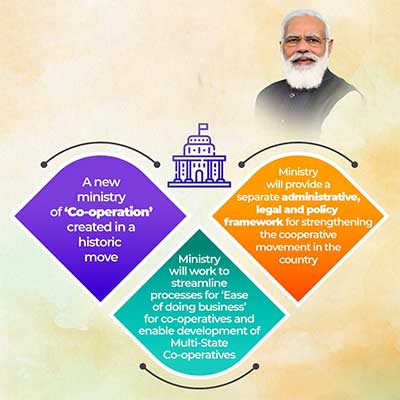
MINISTRY OF CO-OPERATION
CONTEXT
- In a historic move, a separate ‘Ministry of Co-operation’ has been created by the Government for realizing the vision of ‘Sahkar se Samriddhi’.
MORE ABOUT NEWS
- In a historic move, a separate ‘Ministry of Co-operation’ has been created by the Modi Government for realizing the vision of ‘Sahkar se Samriddhi’.
- This ministry will provide a separate administrative, legal and policy framework for strengthening the cooperative movement in the country.
- It will help deepen Co-operatives as a true people based movement reaching upto the grassroots.
- In our country, a Co-operative based economic development model is very relevant where each member works with a spirit of responsibility.
- The Ministry will work to streamline processes for ‘Ease of doing business’ for co-operatives and enable development of Multi-State Co-operatives (MSCS).
- The Central Government has signaled its deep commitment to community based developmental partnership.
CO-OPERATIVES IN INDIA
HISTORY OF COOPERATIVE MOVEMENT IN INDIA
- The experience of British government with India’s peasant society on occasions of famine, scarcity gives the idea of providing some financial assistance to the village people.
- It was also found that Indian peasantry always suffered from lack of funds required for the development of farm produce.
- This prompted the British government to establish credit cooperative societies in the villages. The first Cooperative Credit Societies Act was passed in 1904.
- The term Cooperative Societies came into existence when the farmers of Pune and Ahmednagar (Maharashtra) spearheaded an agitation against the money lenders who were charging exorbitant rates of interest.
CORE PRINCIPLES OF COOPERATIVES
- Voluntary and open membership
- Democratic member control
- Member economic participation
- Autonomy and independence
- Education, training and information
- Cooperation among cooperative
- Concern for community
REASONS COOPERATIVES ARE IMPORTANT TO POVERTY REDUCTION
- Co-ops directly answer community needs, adjusted to local concerns. They are anchors that distribute, recycle and multiply local expertise, resources and capital. Autonomous cooperatives reach the poorest people in the community, offering upward mobility and basic infrastructure ignored by large businesses.
- Co-ops help build peaceful societies –In the process of transforming poverty-ridden communities into vibrant economies, cooperatives contribute to skill-development and education. They bolster gender equality and improve the health and living standards of an entire community.
- Co-ops enable farmers to obtain higher returns – Agricultural and fishing cooperatives support its members by providing training, credit and resources.
- Worker co-ops promote collaborative entrepreneurship and economic growth – Cooperatives reduce individual risk in much-needed business ventures and create a culture of shared productivity, decision-making and creative problem-solving.Only 10 percent of co-ops fail while 60 to 80 percent of businesses fail; in fact, cooperatives can revive communities by allocating funds to rising workers with vested interests. Credit co-ops also supply money to start a new business or repair current ones.
- Co-ops create competition within local markets – Since services come at a cost to members, pricing adjustments occur to benefit members and impact other organizations in order to compete at the same efficiency.
- Industrial and craft co-ops help members produce marketable products –In addition to training, shared facilities allow members to access raw materials and technical machinery otherwise unavailable in rural areas. These cooperatives can provide an additional source of income for families and allow them to grow in their communities, rather than travel to urban centers at a high cost.
CAUSES OF SLOW PROGRESS
Despite rapid growth the overall progress of cooperative movement during 100 years of its existence is not very impressive. Following are the possible reasons for slow and haphazard growth in cooperative sector.
- Government Interference -Cooperative societies are imposed upon the people. This does bring about an increase in the membership of the societies. However, the spirit of cooperation cannot flower fully in these circumstances.
- Mismanagement and Manipulation – Over the years, this truly democratic idea got corrupted and farmers with larger holdings grew more powerful. In practice, this altered the power structure of the cooperatives. In the elections to the governing bodies of the sugar factories, money became such a powerful tool that the top posts of chairman and vice-chairman usually went to the richest farmers even though the majority of members were farmers with small- or medium-sized holdings.
- Lack of Awareness -People are not well informed about the objectives of the movement, the contributions it can make in rebuilding the society and the rules and regulations of cooperative institutions. Unfortunately, no special efforts have been made in this direction.
- Restricted Coverage:
- The cooperative movement has also suffered on account of two important limitations on itsworking. One is that the size of these societies has been very small. Most of these societies areconfined to a few members and their operations extended to only one or two villages.
- Second is the most of the societies have been single purpose societies. For this reason, these societies are unable to take a total view of the persons seeking help, nor can they analyze and solve problems from different angles.
- Functional Weakness – The cooperative movement has suffered from inadequacy of trained personnel right from its inception.
CONCLUSION
- The cooperative structure has managed to flourish and leave its mark only in a handful of states like Maharashtra, Gujarat, Karnataka etc. Under the new Ministry, the cooperative movement would get the required financial and legal power needed to penetrate into other states.
- Cooperative institutions get capital from the Centre, either as equity or as working capital, for which the state governments stand guarantee. This formula had seen most of the funds coming to a few states such as Maharashtra, Gujarat, Karnataka while other states failed to keep up. New cooperative ministry will give fillip to this idea in other states.
